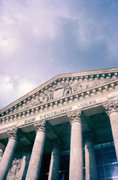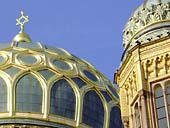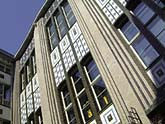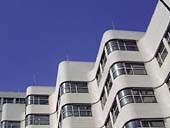 Sights Sights
 Medieval Remnants Medieval Remnants
 Prussian Glory Prussian Glory
 Nation to Republic Nation to Republic
 Nazi Germany Nazi Germany
 Divided City Divided City
 Modern Capital Modern Capital
 Tours Tours

|
The Reichstag Building
www.bundestag.de/htdocs_e/index.html
Platz der Republik 1, 11011 Berlin - Tiergarten | Tel: 227 32152, Fax: 227 30027 | S-Bahn Unter den Linden, Bus 100 | Times: Daily from 8:00 - 24:00 (admission until 22:00) | Admission: Free although prior registration is necessary for visits to the plenary chamber
map:
 No building in Germany has undergone quite as many political and structural transformations as the Reichstag. The Reichstag has closely escaped destruction many times during its 100 year history, and although it has undergone some major transformations over the years (not to mention the legendary "wrapping" of the the building in the summer of 1995 by the artist Christo and his wife), it has never lost its symbolic political meaning for the German people. One year after reunification in 1991 the Bundestag decided that Berlin should once again become the seat of German government and having recently undergone extensive restoration work (following the design of British architect Norman Foster) the building is now once again home of the German Parliament (the Bundestag). The newly constructed metal glass dome over the parliamentary chamber offers good rooftop views over the city but an early start is highly recommended for those who don´t like queuing. No building in Germany has undergone quite as many political and structural transformations as the Reichstag. The Reichstag has closely escaped destruction many times during its 100 year history, and although it has undergone some major transformations over the years (not to mention the legendary "wrapping" of the the building in the summer of 1995 by the artist Christo and his wife), it has never lost its symbolic political meaning for the German people. One year after reunification in 1991 the Bundestag decided that Berlin should once again become the seat of German government and having recently undergone extensive restoration work (following the design of British architect Norman Foster) the building is now once again home of the German Parliament (the Bundestag). The newly constructed metal glass dome over the parliamentary chamber offers good rooftop views over the city but an early start is highly recommended for those who don´t like queuing.
|
New Synagogue
map:
 Gleaming over the rooftops of the trendy Scheunenviertel is the impressive golden dome of the Neue Synagogue. This was once the heart of Jewish Berlin, a status which it is rapidly regaining in the aftermath of reunification. The synagogue was inaugurated in 1866 in response to the increasing numbers of liberal Jews in Berlin, and became known as a centre for liberal Jewish thought and Jewish sacred music. Due to the bravery of a local police officer, the synagogue was almost completely spared from the destruction of Kristallnacht on the night of the 9th of November, 1938, but sadly fell victim to Allied bombing in the late stages of the war. The ruins were then blown up by the socialist authorities in 1958 on the grounds that they were unsafe. After the magnificent restoration of the dome and facade, the complex was opened to the public in 1995. The small museum contains fragments of the synagogue found during excavations, and provides a glimpse through glass walls into the vast space which used to enclose the sanctuary. Liberal services are held in a small adjacent prayer room. Gleaming over the rooftops of the trendy Scheunenviertel is the impressive golden dome of the Neue Synagogue. This was once the heart of Jewish Berlin, a status which it is rapidly regaining in the aftermath of reunification. The synagogue was inaugurated in 1866 in response to the increasing numbers of liberal Jews in Berlin, and became known as a centre for liberal Jewish thought and Jewish sacred music. Due to the bravery of a local police officer, the synagogue was almost completely spared from the destruction of Kristallnacht on the night of the 9th of November, 1938, but sadly fell victim to Allied bombing in the late stages of the war. The ruins were then blown up by the socialist authorities in 1958 on the grounds that they were unsafe. After the magnificent restoration of the dome and facade, the complex was opened to the public in 1995. The small museum contains fragments of the synagogue found during excavations, and provides a glimpse through glass walls into the vast space which used to enclose the sanctuary. Liberal services are held in a small adjacent prayer room.
|
Kaiser Wilhelm Memorial Church (Kaiser-Wilhelm-Gedächtniskirche)
Breitscheidplatz , 10789 Berlin - Charlottenburg | Tel: 218 50 23, Fax: no fax | S+U Zoologischer Garten | Times: Mon-Sat 9am - 7pm, old church Mon-Sat 9am-4pm | Price: Free entry.
map:
The original neo-romanesque structure, built in honour of Kaiser Wilhelm I, was partially destroyed by the Allied bombing on November 22nd 1943 leaving only the west tower. Inside, there is a small exhibition including some before and after photos. Some of the original ceiling mosaics and elaborate masonry can still be seen, but nothing can disguise the fact that it was constructed in the late 19th century. A new hall of worship to the west of the old tower was finished in 1961. Its octagonal shape and multitude of blue stained glass windows are certainly very striking, if a little out of place, but the feeling of calm created within is to be sampled. To the other side of the old tower, the architectural chaos is topped off by a tall, modern, hexagonal bell tower of which the ground floor is a One World shop.
|
Hackesche Höfe
Rosenthaler Str. 40-41, 10178 Berlin - Mitte | U Weinmeisterstr, S Hackescher Markt |
map:
 Built in 1907 by a group of young Jewish idealists, this series of courtyards was owned by a Jewish businessman until 1939, when he was forced to leave the country and relinquish his assets to the Nazis. Although surviving the war intact, it was allowed to remain in a state of disrepair until it was returned to the descendants of its rightful owner after reunification. To prove a point to its temporary guardians of thirty years, it was sold on to a large developer who renovated it over a course of three years until it was re-opened in 1996. It is now, as it was before the war, a mixed-use complex incorporating flats, cinemas, theatres, galleries and ridiculously expensive shops. The supposedly beautiful Art-Nouveau style tiled walls can, to the untrained eye, appear much like the decor of an up-market bathroom. Whatever your tastes, it´s good to see capitalism pumping new blood through the arteries of quite an average piece of architecture. Built in 1907 by a group of young Jewish idealists, this series of courtyards was owned by a Jewish businessman until 1939, when he was forced to leave the country and relinquish his assets to the Nazis. Although surviving the war intact, it was allowed to remain in a state of disrepair until it was returned to the descendants of its rightful owner after reunification. To prove a point to its temporary guardians of thirty years, it was sold on to a large developer who renovated it over a course of three years until it was re-opened in 1996. It is now, as it was before the war, a mixed-use complex incorporating flats, cinemas, theatres, galleries and ridiculously expensive shops. The supposedly beautiful Art-Nouveau style tiled walls can, to the untrained eye, appear much like the decor of an up-market bathroom. Whatever your tastes, it´s good to see capitalism pumping new blood through the arteries of quite an average piece of architecture.
|
Shell House
map:
Surprisingly perhaps, Hitler was never a big fan of Berlin- primarily because of its liberal and modernist leanings. The sight of buildings like Emil Fahrenkamp's Shell Haus drove him wild and if he'd had his own way he would have flattened large portions of the city and rebuilt it in grand Nazi style. The Shell Haus built in 1930 was one of the first steel framed "high-rise" buildings to appear on the Berlin skyline. Its flowing curves, lightness of style and use of glass provide a stark contrast to the Nazi architecture built later in the 1930s.
|

 top of page top of page
 ©
1999-2011 Berlin Information Group ©
1999-2011 Berlin Information Group anything missing or wrong? anything missing or wrong?
|

|

